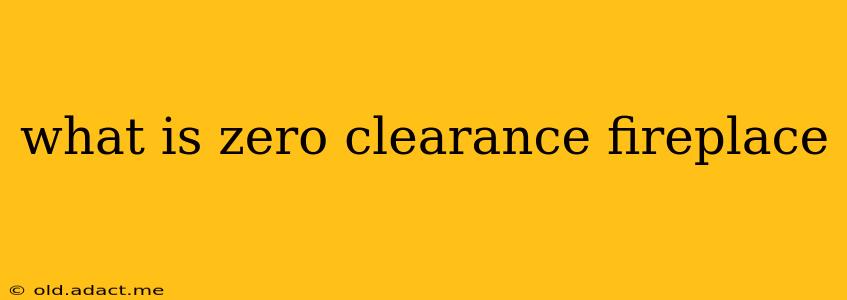A zero-clearance fireplace is a prefabricated fireplace designed for installation with minimal distance between its exterior and combustible materials like wood framing. Unlike traditional masonry fireplaces which require significant clearances for safety reasons, zero-clearance models incorporate advanced fire-resistant materials and construction to significantly reduce this required space. This allows for installation closer to walls and other building components, opening up design possibilities and saving valuable space.
What are the benefits of a zero clearance fireplace?
The primary benefit is its space-saving design. This makes it ideal for smaller homes or rooms where traditional fireplaces wouldn't be feasible. Beyond space, zero-clearance fireplaces offer several other advantages:
- Easier Installation: Compared to building a masonry fireplace, the installation of a zero-clearance model is significantly quicker and less labor-intensive. They arrive pre-fabricated and ready for assembly, often requiring less specialized expertise.
- Cost-Effective: Although the initial purchase price might be comparable or even slightly higher than some traditional options, the reduced labor costs associated with installation often make them more budget-friendly overall.
- Variety of Styles and Designs: Zero-clearance fireplaces come in a wide range of styles and finishes, from traditional to modern, allowing homeowners to find a model that complements their home's aesthetic.
- Improved Efficiency: Many models incorporate advanced features designed to improve efficiency and reduce heat loss, resulting in potentially lower operating costs.
How does a zero clearance fireplace work?
Zero-clearance fireplaces utilize a double-walled construction. The inner wall is designed to withstand intense heat, while the outer wall remains cool to the touch. This is achieved through the use of high-temperature materials and an air gap between the walls, which provides insulation and helps prevent heat transfer to surrounding materials. The air gap is crucial to the safety and functionality of the appliance. Proper venting is also critical to ensure safe and efficient operation.
What are the different types of zero clearance fireplaces?
Zero-clearance fireplaces are available in various types to suit different preferences and needs:
- Direct-vent fireplaces: These models vent directly through the outside wall, eliminating the need for a chimney. This makes them ideal for new construction or situations where a chimney isn't available.
- B vent fireplaces: These fireplaces use a double-walled vent system, allowing for venting through a chimney.
The choice between direct-vent and B-vent systems depends largely on existing home structures and installation possibilities. Some models also offer features such as built-in blowers to circulate heated air throughout the room more efficiently.
How much does a zero clearance fireplace cost?
The cost of a zero-clearance fireplace can vary considerably, depending on factors such as size, features, brand, and finishes. Prices generally range from a few hundred dollars to several thousand dollars.
Are zero clearance fireplaces safe?
Yes, when properly installed and maintained, zero-clearance fireplaces are safe. Their design and construction incorporate fire-resistant materials to prevent heat transfer to combustible materials. However, always follow the manufacturer's installation and operating instructions carefully. Regular inspection and maintenance are crucial to ensure continued safe operation. A qualified installer can ensure proper installation, minimizing risks.
Do I need a permit to install a zero clearance fireplace?
Building permits are usually required for installing any type of fireplace, including zero-clearance models. Check with your local building department to determine the specific requirements in your area. Failure to obtain necessary permits can lead to fines or legal issues.
What is the difference between a zero clearance fireplace and a traditional fireplace?
The key difference lies in the installation requirements and construction. Traditional fireplaces require significant clearances around their structure to prevent fire hazards, while zero-clearance fireplaces are designed for close proximity to combustible materials due to their advanced fire-resistant construction. Traditional fireplaces are typically masonry structures, requiring substantial construction time and expertise, whereas zero-clearance fireplaces are pre-fabricated for simpler installation. Aesthetically, both offer a wide range of styles, ensuring options to suit any home décor.
This comprehensive overview should provide a thorough understanding of zero-clearance fireplaces. Remember to consult with a qualified professional for advice specific to your home and circumstances before purchasing and installing a zero-clearance fireplace.
